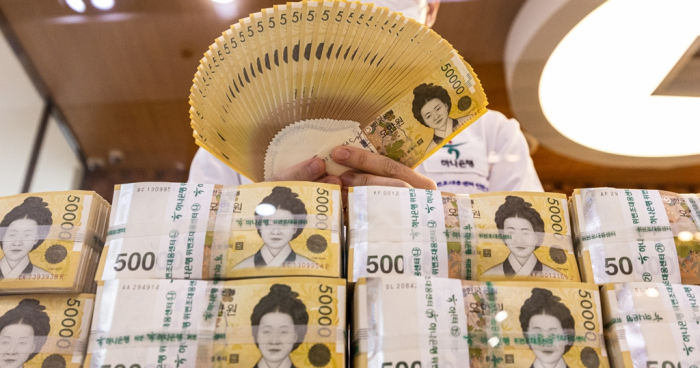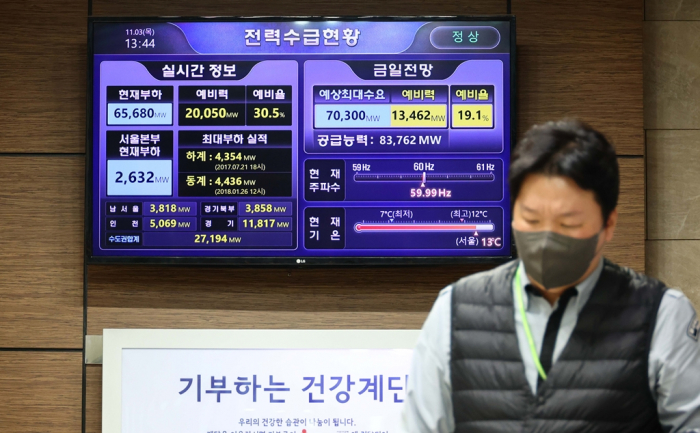Corporate bonds
KEPCO turns from bonds to banks for money on govt plans
Korea asks KEPCO and local banks not to issue bonds to stabilize local market, help companies with lower ratings raise money
By Nov 21, 2022 (Gmt+09:00)
3
Min read
Most Read
LG Chem to sell water filter business to Glenwood PE for $692 million


Kyobo Life poised to buy Japan’s SBI Group-owned savings bank


KT&G eyes overseas M&A after rejecting activist fund's offer


StockX in merger talks with Naver’s online reseller Kream


Mirae Asset to be named Korea Post’s core real estate fund operator



Korea Electric Power Corp. (KEPCO) is set to raise 600 billion won ($442 million) from a local bank in a plan to seek loans to secure money instead of usual bond sales as the government steps up to stabilize the local debt market.
KEPCO, which is expected to report a record loss this year, has decided to borrow the money from Hana Bank at interest rates of 5.5-6.0% per annum after bidding to raise operating funds among the four major domestic lenders of Hana, Kookmin Bank, Shinhan Bank and Woori Bank, according to sources from the government and industry on Monday.
The state-run company plans to raise more than 2 trillion won including the money from Hana in separate biddings. It is scheduled to open the second bidding on Nov. 22, in which Kookmin, Hana and Woori were known to participate.
“It is fine to increase loans from banks if they guarantee similar interest rates with ones of corporate bonds,” said a KEPCO official.
The country has asked KEPCO to seek money from banks instead of bond sales to stabilize the local debt market. KEPCO, which has a Triple-A credit rating, had heavily relied on the market to save itself from mounting losses, having sold 25.5 trillion won in new long-term corporate bonds so far this year, more than double the 10.4 trillion won in the entire 2021.
Such an increase pushed up interest rates on the AAA-rated bonds to 5.95% this month from 2.71% in January.
The market had more problems as KEPCO bonds absorbed most of the liquidity in the market, preventing other companies with lower credit ratings from selling their own debt. The market has been further squeezed by a slumping property market and the fallout from a domestic developer's debt default on a Legoland theme park.
DO BANKS HAVE ENOUGH MONEY?
KEPCO is expected to see a record loss of some 35 trillion won this year on rising energy prices, casting doubts over whether the local banks’ emergency liquidity injection is enough to save the company.
To cut the loss, the government is set to cap the rise in the system marginal price (SMP), the price that KEPCO pays to electricity producers, next month while discussing measures to raise electricity tariffs in 2023 with related ministries.
“Massive power tariff hikes are the fundamental solution to KEPCO’s losses,” said an industry source.

Meanwhile, the government wants local banks to rescue KEPCO before those measures are implemented. South Korea’s major financial holding companies are set to provide a combined 95 trillion won, including loans for KEPCO, into the market by year-end.
But those lenders face problems in raising money for the liquidity injection as the government requested them not to issue bonds, which will absorb liquidity in the market. The authority also asked banks not to increase saving interest rates as that could move money from financial markets to banks.
MARKET NEEDS AT LEAST 200 TRILLION WON MORE
The market needs an additional 200 trillion won to improve the liquidity situation as the failure of one or two companies could cause a chain reaction of bankruptcies, bond market participants said. In addition, overseas alternative assets, in which pension funds and insurers have heavily invested over the last five years, have started showing signs of crisis.
“Signals to curb interest rate hikes, and additional liquidity supply will be able to ease concerns over the market in the short term,” said a chief investment officer at a major pension fund.
Earlier in the day the government launched a program of 1.8 trillion won to buy project financing asset-backed commercial papers (PF ABCPs) guaranteed by securities houses.
About half of the PF ABCPs of 34 trillion won will expire this month. Smaller securities firms such as Daol Investment & Securities Co. and DB Financial Investment Co. need to roll over 1.1 trillion won in PF ABCPs within this year.
Last month, the government pledged to inject at least 50 trillion won to stabilize short-term money and corporate bond markets rattled by the Legoland Korea developer’s debt default.
“The crisis will end only when the real economy recovers,” said the head of the financial market division at a domestic bank. “It is unclear if we can hold out until then, although we may be able to take care of the most urgent problem.”
Write to Ji-Hoon Le and Sang-Yong Park at lizi@hankyung.com
Jongwoo Cheon edited this article.
More to Read
-
 Corporate bondsKorean firms at risk of credit rating downgrade on Legoland woes
Corporate bondsKorean firms at risk of credit rating downgrade on Legoland woesNov 13, 2022 (Gmt+09:00)
2 Min read -
 EarningsKEPCO to see record loss 2022 on slower power tariff hikes
EarningsKEPCO to see record loss 2022 on slower power tariff hikesNov 11, 2022 (Gmt+09:00)
1 Min read -
 Corporate bondsBOK to ease Legoland developer default-led credit crunch
Corporate bondsBOK to ease Legoland developer default-led credit crunchOct 28, 2022 (Gmt+09:00)
2 Min read -
 Corporate bondsKorea's $35 bn plan yet to ease Legoland default woes
Corporate bondsKorea's $35 bn plan yet to ease Legoland default woesOct 25, 2022 (Gmt+09:00)
4 Min read -
 Banking & FinanceBanks' term deposits attract largest sum in 20 yrs
Banking & FinanceBanks' term deposits attract largest sum in 20 yrsOct 13, 2022 (Gmt+09:00)
1 Min read
Comment 0
LOG IN


